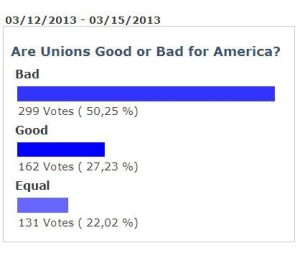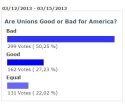This weeks informal myMotherLode.com poll question about unions was similar to a recent “On The Street” segment conducted by reporter Tracey Petersen. “On The Street” is a weekly vignette that airs on 1450 KVML, Star 92.7 and 93.5 KKBN and is posted here.
The myMotherLode.com poll question was: Are Unions Good or Bad for America? Fifty percent answered Bad, 27 percent said Good, and 22 percent said Equal.
At the end of January the U.S. Bureau of Labor Statistics reported its 2012 Current Population Survey (CPS) findings. In 2012, 14.4 million workers were members of a union. The union membership rate–the percent of wage and salary workers who were members of a union–was 11.3 percent, down from 11.8 percent in 2011. In 1983, the first year the data is available, the union membership rate was 20.1 percent, and there were 17.7 million union workers or 3.3 million more in unions than in 2012.
Current Population Survey (CPS) is a monthly sample survey of 60,000 households, highlights from the 2012 data:
- Public-sector workers had a union membership rate (35.9 percent) more than
five times higher than that of private-sector workers (6.6 percent). - Workers in education, training, and library occupations and in protective
service occupations had the highest unionization rates, at 35.4 and 34.8
percent, respectively. - Among states, New York continued to have the highest union membership rate
(23.2 percent), and North Carolina again had the lowest rate (2.9 percent). - California Union Membership increased slightly to 2,489,000 (a 17.2 percent rate)
- The lowest union membership rate occurred among those ages 16 to 24 (4.2 percent).
Within the public sector, local government workers had the highest union membership rate, 41.7 percent. This group includes workers in heavily unionized occupations, such as teachers, police officers, and firefighters. The associated press reports that more than half of the nation’s 2.1 million government workers may be required to take furloughs if agencies are forced to trim budgets. The Defense Department expects to furlough 800,000 civilian workers for 22 days each. Other federal agencies are likely to furlough several hundred thousand more workers.
Private-sector industries with high unionization rates included transportation and utilities (20.6 percent) and construction (13.2 percent). The lowest unionization rates were in sales and related occupations (2.9 percent) and farming, fishing, and forestry occupations (3.4 percent).
Eight states had union membership rates below 5.0 percent in 2012. North Carolina had
the lowest rate (2.9 percent), followed by Arkansas (3.2 percent) and South Carolina
(3.3 percent). Three states had union membership rates over 20.0 percent in 2012:
New York (23.2 percent), Alaska (22.4 percent), and Hawaii (21.6 percent).


